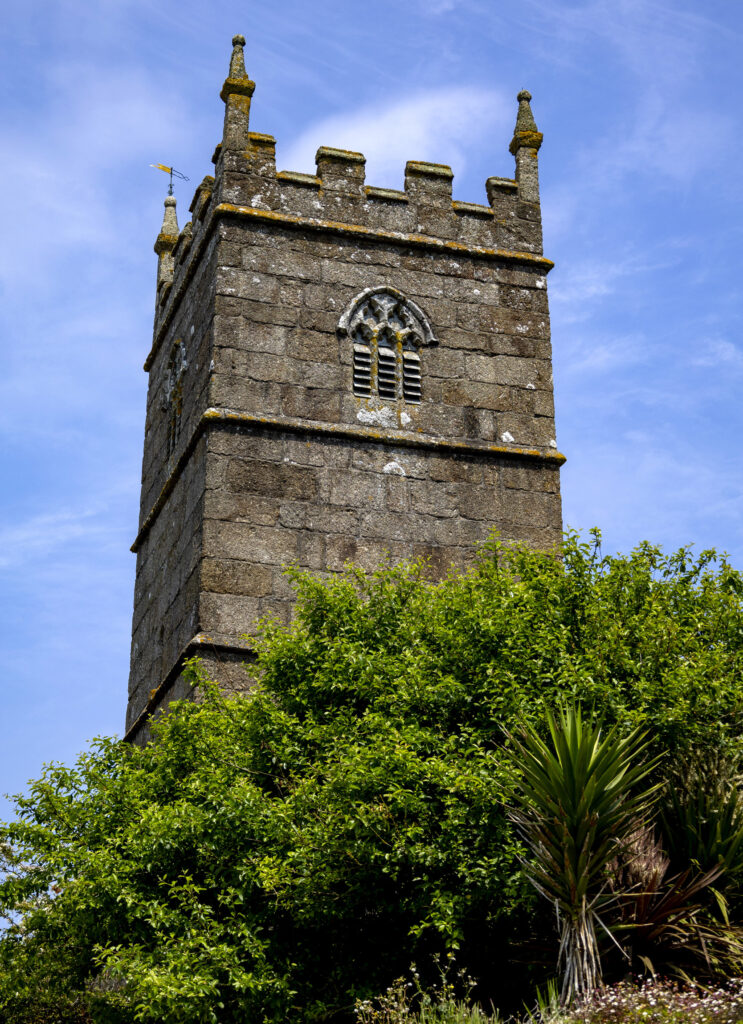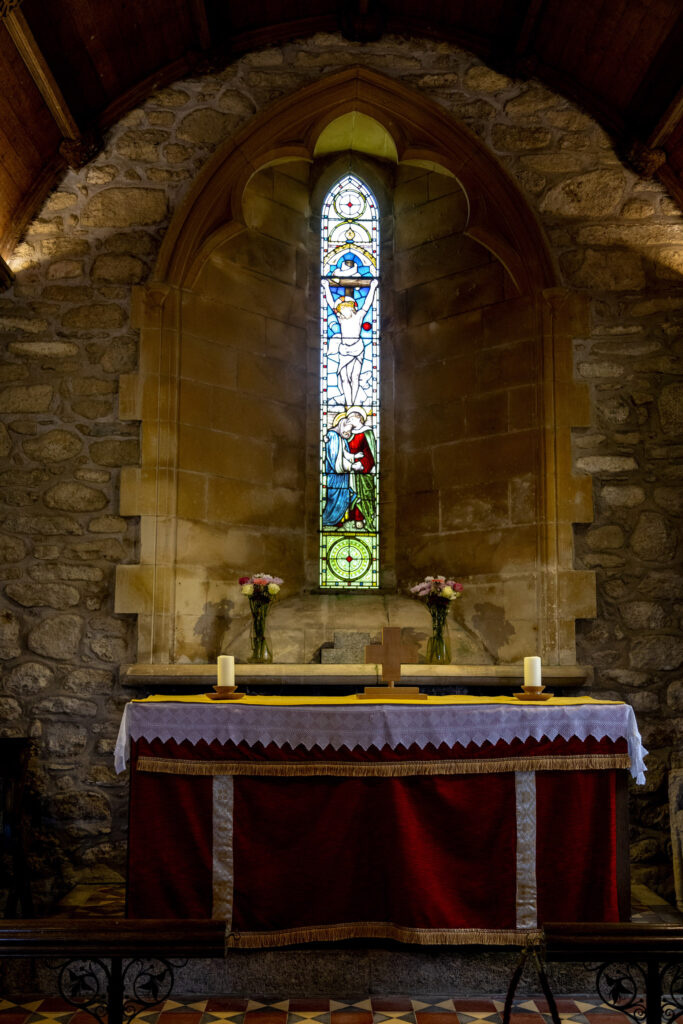If you take the B3306 road from St. Ives to St. Just, you will pass through some of the most dramatic scenery in Cornwall. The road leaps, dips and twists through a range of bare granite hills, grotesque in outline, yet grand in their solitude. Rosewall is the first hill on your left, and this is my favourite. From the top you can see right across the width of West Penwith.
Eastwards is St. Ives Bay with its Godrevy Lighthouse, Mount’s Bay to the south studded by the gem of St. Michael’s Mount, and northwards runs the deep Atlantic. The west is blocked out by the hills which run in descending height right down to Lands End. Hills with lovely names like Trevalgan, Trendrine, Trewey, Cam Galva, Watchcroft, and others. The little village at the foot of Rosewall Hill is Halsetown. Sir Henry Irving spent his childhood there with his aunt, whose house still stands opposite the inn.
Ghosts of history haunt the whole of West Penwith, but nowhere will you find the atmosphere of age and mystery as gripping as here amid these hills. Four miles along the road you come to Eagles Nest. A lovely sweep of moorland between two hills and green fields covering the deep valley to the sea.
The next turning on the right leads to the village of Zennor. A very neat and clean little village composed mostly of miners’ cottages in rows of the porch is three or four with small well filled gardens in front. The church, vicarage and inn dominate the centre. The church is dedicated to St. Sinara, a saint who came from Ireland with St. Ia – when she landed at St. Ives. The earliest mention of the church is in 1150 when it was part of Tywardreath Priory. In 1270, the Abbot of Glasney became the Rector and he appointed a vicar. Originally the church was cruciform, but about 1450 the north transept was removed and the north aisle built. The south-east chancel is Norman and older than any other part.
By the south gate is a Cornish cross which was found on the site and is 7th 0r 8th century. On the wall to the left of a plaque to the memory of John Davey who died in 1890 and said to be the last man in the district to speak the Cornish language. Just above this, on the tower, is a sundial made by Paul Quick in 1737. A winged figure looks down on two pairs of crossed bones on the sundial to show that even time ends in death.

When I lifted the latch and stepped inside, an atmosphere of loving reverence seemed to reach me, somewhat awe inspiring and emphasising that this was God’s House, and he was at home.
Massive granite pillars and arches support the wooden ceiling of the main church. The richness and grandeur of a city church is not felt here as you walk down the bare red and black tiled aisles. Even the strip of carpet in front of the altar is very narrow, but the atmosphere of stillness, and the warmth of sanctuary is so intense, that the visitor feels much more at home than in any huge cathedral.

The windows are very interesting. The one over the main altar is the smallest in the church. It portrays the Crucifixion with the sun on the left and the moon on the right. The window above the wooden screen shows the Annunciation, Adoration and Presentation in beautiful colour. The side chapel window has an unusual theme with Christ walking on the sea and the angel of the Last Day blowing a trumpet with the sea giving up its dead. St. Peter, St. John and St. Paul are shown in the other side chapel window which was given in memory of William Borlase, Vicar of Zennor from 1768 to 1812; he was a relative of Admiral Borlase.

Around the corner by the “Squint” is a window showing St. Sinara, patron saint of the church, and St. Ia, patron saint of St. Ives parish church. The church can seat about 300 people, and although the pews are comparatively plain, there is one bench end in the side chapel which is very famous. The carving on it, which is thought to be five or six hundred years old, shows the figure of a mermaid with a comb and a glass in her hand. Most Cornish people know the legend of the Mermaid of Zennor – how she fell in love with Matthew Trewhella after hearing him singing in the church choir. She lured him away down the stream which flows from the centre of the village to the beach, and his singing can still be heard echoing round the cliffs and caves of Poldour Cove at Zennor Head. In this church where the history of centuries seem to pervade, the font stands out as quite modern. Although it belongs to the early 15th century, half the bowl and the four supporting pillars were restored probably late 19th century or early this century. It was springtime when I visited Zennor church and on the font was a simple bowl of primroses, beautifully engraved, which seemed to epitomise the simple beauty of this church.

There are 6 bells in the tower. Three are very old and were re-hung in 1717. The treble, third and tenor (the latter weighs 12cwt.) were added later, and all were re-hung in 1926. Leaning on the walls inside the bell tower are some very old memorial stones. One to William Champen, the “henpecked husband” has this little verse on it.
“Hope, fear, false joy and trouble
Are these four winds which daily toss this bubble,
His breath’s a vapour and his life’s a span,
Tis glorious misery to be born a man.”
The churchyard has a distinct ancient and modern part. The grave of the Borlase family has two very ancient Cornish crosses on it, probably 7th or 8th century. A few yards from this grave is the War Memorial. Made of granite, it depicts Shadrach, Meshach and Abednego walking through the burning fiery furnace. I noticed in the modern part, the grave of that grand old Cornish Bard, Robert Morton Nance. Just below the south wall of the tower is a tombstone with the words….
“All that pass by, pray cast an eye,
As you are now, so once was I,
As I am now ere long you’ll be,
Therefore prepare to follow me.”
Such an invitation to the cemetery, I thought!

Zennor Church gets quite a few visitors during the summer months. One wonders if D.H. Lawrence ever set foot in it, when he and his wife lived here in a miner’s cottage during the First World War. I’m sure he would have felt the warmth of welcome which pervades this church set between bare granite hills and blue elvin cliffs of this most enchanting part of the Cornish coast.
The Mermaid Legend as described in the Church in 2023

There was a boy who lived in the village (Zennor) whose name was Matthew Trewhella. He was the son of the churchwarden and came to this Church every Sunday to sing in the choir. He had the most beautiful voice and each Sunday many people would come to hear him sing.
Then one day a Mermaid sitting on the rocks below Zennor in Pendour Cove, heard his voice drifting down from the Church above. She was mesmerised by the sound and every Sunday she would come to the same rock in the Cove to listen to him sing.
She was very beautiful and loved to sing herself. Her voice was hauntingly serene. Then one day she decided to venture up into the village and into the church.
She fell in love with the boy and he with her. She enticed him to, come away with her and they were last seen swimming out to sea, down at Pendour Cove. They were never seen again.
It is thought that the Mermaid Chair, created about 400 years ago, was carved in memory of the Choir Boy, Matthew Trewhella.